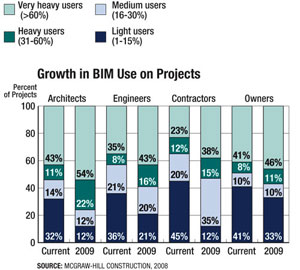First comes “lonely” BIM, when a firm begins to tool up for building-information-modeling-enabled projects. Then comes “social” BIM, when a firm collaborates with other firms using BIM. Next comes “intimate” BIM, when the owner, architect and contractor share risk and reward contractually via BIM-enabled integrated project delivery. Finally, when work gets heavenly, there is “cheruBIM.”
These are the four stages of BIM, at least according to one builder and one architect. The first two stages were coined a while back by John Tocci, who also calls himself the chief enabling officer of Tocci Building Cos., Woburn, Mass. The second two stages were coined by Tocci and Scott Simpson, managing director of the Cambridge, Mass., office of Kling Stubbins, on Nov. 18, at BuildBoston, during their joint presentation on the duo’s first intimate-BIM job, a 55,000-sq-ft office fit-up for BIM vendor Autodesk Inc.’s East Coast headquarters in Waltham, Mass.
Tocci, wearing the architect’s signature turtleneck, and Simpson, wearing the contractor’s shirt and tie, smiled as they created their BIM-stage lexicon, especially when Simpson burst forth with cheruBIM. Two months away from the end of their fast-tracked Autodesk job, they remain in a virtual love fest over BIM-enabled design and construction. “This is the most exciting project from a relational standpoint we’ve ever been involved in,” says Tocci. The builder says he turned to BIM five years ago, before it was ready for prime time, after wearying of fighting, claims and speaking ill of his “design brethren.”
BIM mania is spreading because the tool has great potential for helping produce better architecture, faster and for less cost. It also holds the most promise of uniting a fragmented industry, notorious for inefficiency and litigation. “Everyone sees this as the last best chance to remake our industry the way we want it,” says Tocci, who also is chairman of the Associated General Contractors BIM Forum. “It’s a huge story that goes well beyond BIM,” he adds.
Construction’s soothsayers say it could take 10 to 15 years before BIM, a digital representation of physical and functional characteristics of a facility, becomes truly mainstream. “This is not Shangri-la, the Holy Grail or pixie dust,” says Sean Smith, senior vice president for the 900-person architect-engineer Gresham Smith and Partners, Nashville, and one of the main lecturers for the American Council of Engineering Companies’ tutorials on BIM. “It’s a marathon, not a sprint, and until everyone is on equal footing there will be issues.”
Owners and developers are starting to push for BIM. Designers and contractors are grappling with the paradigm shifts triggered by BIM. BIM is infiltrating all the way down the supply chain to the subcontractors, specialty contractors and the trades.
There is the feeling among some that change is not happening fast enough. Structural engineer Thornton-Tomasetti, an early adopter of BIM, still gets the vast majority of projects in 2D. “It’s the state of the industry,” says Erleen Hatfield, a principal of the New York City-based firm. “Everyone is gung ho on BIM, but not in practice.”
Perhaps the paperless project is still a few years away, but that doesn’t mean BIM use is not growing. In a recent survey of structural engineers, 52% of the 626 respondents said their firm has BIM software. In another BIM market survey recently released, 35% of 302 respondents described themselves as very heavy BIM users, involving at least three of five of their projects, and 45% say they will be very heavy users in 2009.
The 42-page survey, called the “SmartMarket Report on Building Information Modeling,” was conducted June 18 to Aug. 8 by McGraw-Hill Construction, parent of ENR, in collaboration with more than 20 industry stakeholders. The sample of BIM users included 82 architects, 101 structural, civil and mechanical engineers, 80 contractors and 39 owners. The report is available for free download on www.analytics store.construction.com beginning on Dec. 2. Print copies cost $25.
According to the report, architects are BIM’s heaviest users: 43% are heavy users already, and 54% expect to be next year. Contractors report relatively limited BIM use compared to the other groups and could experience “the greatest rise” in use, says the report. All users surveyed expect to “rapidly increase” BIM use next year, states the report, which was conducted before the economic crisis hit its peak.
Half of respondents report BIM has a positive impact on their companies, with only 10% reporting a negative impact. The report concludes that in challenging economic times, BIM use can be a “competitive differentiator” for winning work.
Industry groups are not sitting idly by, watching the BIM struggle. But the fruits of their labors are just ripening and nowhere near proven. Since June, two groups, ConsensusDOCS and the American Institute of Architects, released model BIM contract documents. The ConsensusDOCS 301 BIM Addendum addresses legal issues and obligations, such as who owns the model, information management and allocation of risk, says lawyer Richard H. Lowe, a partner in Duane Morris, Philadelphia. AIA took a different approach and addressed the level of detailing for each building element in a BIM, he says.
The insurance sector is just now considering products that address BIM. The legal community is struggling with clients that are forging ahead, especially into the so-called social BIM—which can blur the line between design and construction responsibility—without what many lawyers consider prudent contractual protection . But most agree that for the potential of BIM to be realized, the tool has to be used collaboratively by all in the supply chain.
Before this happens, obstacles must be overcome on many levels. “The collaborative vision of the construction community has us defining every part and piece to be fabricated and/or delivered and installed,” says Jim Beaty, information technology coordinator for structural engineer LeMessurier Consultants Inc., Cambridge, Mass. “Perhaps identifying and valuing the design and detailing functions to be performed and letting contributors sign up for what they can economically and professionally accomplish could lead to a market-driven shift of scope and compensation.”
There are even greater obstacles to collaboration than defining content providers. The 800-lb gorilla in the room impeding collaborative BIM-enabled virtual design and construction is a lack of software interoperability. The National Institute of Building Sciences, Washington, D.C., is trying to solve this problem by producing a standard, but its development has a long way to go and needs additional resources.
Architect Kimon Onuma, Pasadena, Calif.-based developer of Onuma Planning System software, isn’t waiting for standards to foster collaboration. He has developed Web-based planning charrettes, called BIMStorms. “BIMStorms take the concept of integration and collaboration to a new level by involving stakeholders in what are traditionally disconnected processes,” says Onuma.
It’s a glimpse of the future.





Post a comment to this article
Report Abusive Comment